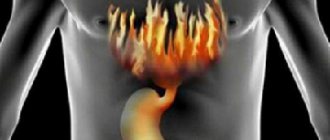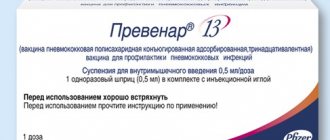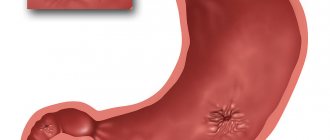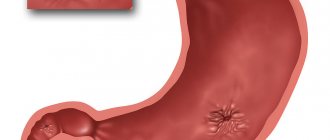Pharmacodynamics and pharmacokinetics
The active component suppresses the production of basal hydrochloric acid in the stomach, as well as that stimulated by acetylcholine , histamine and gastrin HCl. Reduces the activity of pepsin, increases the pH of gastric juice, and reduces the production of HCl.
By increasing the level of glycoproteins , increasing the formation of gastric mucus, stimulating the synthesis of prostaglandins , and the secretion of bicarbonate, the protective and wound-healing effect of the drug is achieved.
The drug helps stop gastric bleeding , promotes healing of damage to the gastric mucosa, and scars stress ulcers .
The drug has a weak effect on the oxidase system of the cytochrome P450 enzyme in the liver system (suppressive effect).
The medicine begins to act within an hour and lasts 12-24 hours. With intravenous administration of solutions with the active ingredient famotidine, the effect is recorded after half an hour. A single dose suppresses secretion for 10-12 hours.
Composition, dosage forms of the drug
The active substance of the drug is famotidine. The compound reduces the secretion of hydrochloric acid and increases the mucus content in gastric juice. The drug has two pharmaceutical forms:
- Tablets for oral use: in dosages of 20 and 40 mg, coated with soluble film. Auxiliary components: talc, starch, silicon dioxide, magnesium stearate. Sold in packs of 10–50 pcs.
- Lyophilized powder for the preparation of injection solutions: white or yellowish free-flowing substrate in ampoules. Available complete with solvent. Cardboard packages of the drug contain 5 ampoules, each containing 20 mg of Famotidine and excipients: mannitol, aspartic acid.
Indications for use of Famotidine
What are the pills for?
The medication is prescribed for hyperacidity of gastric juice , ulcerative lesions of the digestive system, stress ulcers, symptomatic ulcers, Zollinger-Ellison syndrome , NSAID gastropathy, erosive variant of reflux esophagitis, heartburn , for the prevention of recurrent bleeding after surgical interventions on the digestive system, polyendocrine adenomatosis, with systemic mastocytosis .
What other indications exist for the use of Famotidine? The medicine is prescribed to prevent aspiration of gastric juice in patients who are given general anesthesia. The drug is effective for dyspeptic disorders. The drug is prescribed for the prevention of aspiration pneumonitis .
How does Famotidine work?
This is an antiulcer drug. It affects the functions of the gastric mucosa, comprehensively suppressing the production of hydrochloric acid:
- basal;
- stimulated by the enzymes gastrin, pepsin and acetylcholine.
As a result of acid neutralization, the pH level increases, and at the same time the protective effect of gastric secretions increases. Thanks to the production of glycoproteins, alkaline components and prostaglandins, the mucous membrane experiences less irritation, recovers and heals faster. In addition, the drug has a moderate effect on liver enzymes. This helps stop internal bleeding, prevents its development, and accelerates the scarring of ulcerative lesions.
The product dissolves in the stomach cavity within 10–15 minutes. The therapeutic effect of the drug develops over 1 hour and lasts up to 0.5–1 day. One dose of Famotidine significantly reduces the synthesis of hydrochloric acid for up to 12 hours, eliminating characteristic symptoms: stomach pain, heartburn.
Side effects
Digestive tract: epigastric pain, dry mouth, nausea, decreased appetite, vomiting, increased levels of liver enzymes, acute pancreatitis , mixed hepatitis, hepatocellular hepatitis, cholestatic hepatitis.
Sense organs: ringing in the ears, paresis , blurred visual perception.
Genitourinary system: decreased libido, amenorrhea , gynecomastia , hyperprolactinemia .
Agranulocytosis, allergic reactions, tremor, drop in blood pressure, dizziness, asystole, AV block, bradycardia, anaphylactic shock , bronchospasm, myalgia, arthralgia, hallucinations may develop.
Famotidine, instructions for use (Method and dosage)
Instructions for use of Famotidine tablets
Taken orally.
For ulcerative lesions of the digestive system: 0.02 grams twice a day or 0.04 grams before bedtime. In some cases, the amount of the drug is increased to 80-160 mg. Duration of therapy is 4-8 weeks.
In order to prevent relapses of ulcerative lesions, 0.02 grams are prescribed once a day at night.
The initial dose for Zollinger-Ellison syndrome is 20-40 mg 4 times a day, the dose can be increased to 24-48 mg.
Prevention of aspiration of gastric contents: 0.04 grams; before surgery, take 2 hours before surgery. For reflux esophagitis: twice a day, 0.02 grams.
Preparations with Famotidine solution
Intravenously administered slowly over 2 minutes: 20 mg every 12 hours. For the prevention of aspiration pneumonitis: intramuscularly 0.02 grams before surgery, or in the morning on the day of surgery.
Powder for injection is dissolved in sodium chloride 0.9% 5-10 ml.
Famotidine
Famotidine
(lat.
famotidine
) - an antiulcer drug, a blocker of histamine H2 receptors.
Chemical compound:
3-[[[2-[(Aminoiminomethyl)amino]-4-thiazolyl]methyl]thio]-N-(aminosulfonyl)propanimidamide. Empirical formula: C8H15N7O2S3.
Famotidine is the international nonproprietary name (INN) of the drug. According to the pharmacological index, it belongs to the group “III generation H2-histamine receptor blockers”. According to ATC, it belongs to the group “H2-histamine receptor blockers” and has the code A02BA03. "Famotidine" is also the trade name of the drug.
Characteristic.
White or pale yellow crystalline powder. It is highly soluble in acetic acid, slightly soluble in methanol and water, and practically insoluble in ethanol.
Pharmacology
Pharmacological action
- antiulcer. Blocks histamine H2 receptors, inhibits basal and stimulated secretion of hydrochloric acid; inhibits pepsin activity.
Famotidine is not completely absorbed from the gastrointestinal tract, bioavailability is 40–45%, increases under the influence of food and decreases when using antacids. Plasma protein binding is 15–20%. Cmax is reached after 1–3 hours. 30–35% is metabolized in the liver to form S-oxide and excreted by the kidneys by glomerular filtration and tubular secretion. 25–30% of the dose taken orally and 65–70% of the dose administered intravenously are found unchanged in the urine. T½ - 2.5–3 hours. In patients with severe renal failure (creatinine Cl below 10 ml/min), it increases to 20 hours (dose adjustment required). After oral administration, the effect begins within 1 hour, reaches a maximum within 3 hours and lasts 10–12 hours. Under conditions of intravenous administration, the maximum effect develops after 30 minutes. A single dose (10 and 20 mg) suppresses secretion for 10–12 hours.
Use of famotidine.
Peptic ulcer of the stomach and duodenum (treatment and prevention of exacerbations), symptomatic ulcers, erosive esophagitis, reflux esophagitis, Zollinger-Ellison syndrome, bleeding from the upper gastrointestinal tract (iv), prevention of erosive and ulcerative lesions of the gastrointestinal tract while taking NSAIDs and aspiration of gastric contents during general anesthesia.
One of the significant disadvantages of famotidine, common to all H2-blockers, is the effect of tachyphylaxis - the patient’s addiction to the drug, when the effect of the drug noticeably decreases with repeated use.
Famotidine tachyphylaxis.
Intragastric pH during therapy with proton pump inhibitor omeprazole and famotidine (Gostishchev V.K., Evseev M.A.). A decrease in the antisecretory effectiveness of famotidine is clearly visible upon repeated administration . Contraindications.
Hypersensitivity, pregnancy, breastfeeding.
Side effects.
Dry mouth, loss of appetite, nausea, vomiting, abdominal discomfort, increased levels of transaminases in the blood serum, cholestatic jaundice, increased fatigue, tinnitus, headache, rarely hallucinations, fever, arrhythmias, muscle pain, arthralgia, dry skin, allergic reactions: angioedema, itching, urticaria, conjunctivitis, bronchospasm; irritation at the injection site.
Interaction.
When taking famotidine and ketoconazole simultaneously, the absorption of ketoconazole may be reduced. When using famotidine with antacids, the interval between taking them should be at least 1-2 hours.
Overdose
.
- Symptoms: worsening side effects.
- Treatment: gastric lavage, symptomatic or supportive therapy.
Method of administration and dose. Inside
. For exacerbation of gastric and duodenal ulcers, 40 mg at night or 20 mg 2 times a day (morning and evening), course duration - 4-8 weeks; to prevent exacerbations - 20 mg 1 time per day at night for 6 months. For reflux esophagitis - 20 mg 1-2 times/day for 6-12 weeks, Zollinger-Ellison syndrome - 20-40 mg 4 times/day (if necessary, increase the dose of the drug).
Intravenously (stream or drip).
The average dose is 12 mg every 12 hours. For Zollinger-Ellison syndrome: initial dose - 12 mg every 6 hours, subsequently the dose is adjusted; to prevent aspiration of gastric contents before general anesthesia: 20 mg on the day of surgery or at least 2 hours before surgery.
Precautionary measures.
For patients with impaired renal function (creatinine clearance below 30 ml/min), the daily dose is reduced to 20 mg. It is not recommended to prescribe the drug to children. When treating gastric and duodenal ulcers, it is necessary to exclude the presence of a malignant tumor in the patient (examination of a biopsy from the area of the ulcer). Use with caution in case of liver dysfunction.
Use during pregnancy and breastfeeding.
Famotidine is contraindicated for use during pregnancy and lactation. The FDA category of risk for the fetus when used by pregnant women is B (animal studies have not revealed the risk of negative effects on the fetus; there have been no adequate studies in pregnant women).
Famotidine is generally a prescription drug
.
However, drugs containing small doses (10 mg) of famotidine are available over the counter
(Kvamatel mini).
By Decree of the Government of the Russian Federation of December 30, 2009 No. 2135-r, famotidine (lyophilisate for the preparation of a solution for intravenous administration; film-coated tablets; film-coated tablets) is included in the List of vital and essential medicines.
Famotidine and coronavirus.
There are studies indicating a link between proton pump inhibitors and the risk of COVID-19. They indicate the importance of deprescribing proton pump inhibitors in conditions of increased risk of COVID-19. The preferred antisecretory drug is famotidine, which improves the condition of patients infected with SARS-CoV-2. The high therapeutic effectiveness of H2-blockers, in particular famotidine, in such patients is due not only to the mild suppression of acidic gastric secretion, but also to pronounced antioxidant properties (Khomeriki N.M.).
Trade names of drugs with active ingredients
famotidine: Antodin, Blockacid, Gasterogen, Gastrosidin, Kvamatel, Kvamatel mini, Lecedil, Pepsidin, Ulfamid, Ulceran, Famonit, Fampopsin, Famosan, Famotel, Famotidine, Famotidine-ICN, Famotidine-OBL, Famotidine-AKOS, Famotidine-Acri, Famotidine -Apo, Famotidine-STADA, Famocid.
Manufacturer
: Biocom, Stavropol Russia; ZiO-Zdorovye, Russia; Makis-Pharma, Russia; Obolensk Pharmaceutical Enterprise, Russia; Serena Pharma/Shreya Life Sciences, India; Pharmstandard-Leksredstva, Russia; Hemofarm D.D., Yugoslavia; Hemofarm concern A.D., Yugoslavia; Yaka-80, Macedonia.
Brands of famotidine are registered in the USA: prescription (Pepcid, Duexis) and over-the-counter (over-the-counter), characterized by a reduced content of famotidine and intended for the relief of heartburn (Pepcid AC).
In addition to famotidine, Pepcid Complete and Double Action Complete, registered in the United States, contain the antacids calcium magnesium carbonate hydroxide. Tums Double Action has a similar composition, as well as Gastromax, which has Ukrainian registration.
Descriptions of drugs and instructions
from different manufacturers (pdf):
- For Russia
- official instructions of Akrikhin OJSC: “Instructions for medical use of the drug Famotidine-Akri”, film-coated tablets, 20 mg, dated September 17, 2008.
- “Information about the drugs Kvamatel and Kvamatel mini for medical workers and specialists”, film-coated tablets, 10 mg (Kvamatel mini) and 20 and 40 mg (Kvamatel), lyophilisate for the preparation of a solution for intravenous administration (Kvamatel) Gedeon Richter
- “Instructions for medical use of the drug Famotidine”, tablets, 20 mg, OJSC “Kievmedpreparat”
Materials for healthcare professionals regarding the use of famotidine in the treatment of diseases of the gastrointestinal tract
Articles and reports
- Khomeriki N.M. Features of the treatment of acid-related diseases during the COVID-19 pandemic. Therapeutic archive. T.93, 2.2021. Application. P.55-56.
- Chernov Yu.N., Batishcheva G.A., Alekhin S.M., Zorina M.S. Daily monitoring of intragastric pH in patients with duodenal ulcer and comparative effectiveness of the antisecretory effect of quamatel with various methods of administration // Applied information aspects of medicine. 2015. T. 18, No. 5.
- Dorofeev A.E., Afanasyev M.V. The use of famotidine in patients with gastroesophageal reflux disease in combination with functional dyspepsia // Medical newspaper “Health of Ukraine”. – 2008. – No. 6/1. - With. 33.
- Minushkin O.N., Maslovsky L.V. Report on clinical trials of the drug famocid (India) at the Department of Gastroenterology of the Educational and Scientific Center of the Medical Center of the Administration of the President of the Russian Federation.
- Zatevakhin I.I., Shchegolev A.A., Titkov B.E. Famotidine in the treatment of surgical patients with acid-dependent diseases of the stomach and duodenum // Russian Journal of Gastroenterology, Hepatology, Coloproctology. – 1999. – No. 4. - With. 84–87.
- Deineko N.F., Shargorod I.I., Garsali R.B. Famotidine in the treatment of patients with chronic recurrent pancreatitis // Pharmacist. – 1999. – No. 15.
- Okhlobystin A.V. The use of famotidine for the treatment of acute ulcer bleeding // Russian Medical Journal. – 2002. – T. 10. – No. 8–9.
On the website GastroScan.ru in the “Literature” section there is a subsection “H2-blockers” containing articles devoted to the treatment of diseases of the gastrointestinal tract using H2-blockers of histamine receptors, including the use of famotidine.
Video
Still from video Vovk E.I.
Medicines for the treatment of heartburn and diseases associated with hyperacidity. Clinical pharmacology On the website GastroScan.ru in the “Video” section there is a subsection for patients “Popular Gastroenterology” and subsections “For doctors” and “For medical students and residents”, containing video recordings of reports, lectures, webinars in various areas of gastroenterology for healthcare professionals and medical students.
Famotidine has contraindications, side effects and application features; consultation with a specialist is necessary. Back to section
Interaction
Famotidine inhibits the metabolism of Diazepam , aminophenazone, phenazone , lidocaine, caffeine, tricyclic antidepressants , phenytoin, indirect anticoagulants, Aminophylline , metronidazole, Metoprolol, buformin , glipizide, theophylline, metoprolol, clavulanic acid in the liver.
When taking drugs that depress bone marrow, the risk of developing neutropenia increases. Famotidine reduces the absorption of Ketoconazole and Itraconazole .
Sucralfate and antacids slow the rate of absorption. Famotidine is compatible with sodium chloride, dextrose solution. The drug increases the absorption of clavulonic acid, Amoxicillin .
Precautions and contraindications
The drug requires careful use in hepatosis, cirrhosis and other liver diseases, inflammation of the gallbladder, renal failure, nephritis. These pathologies increase the risk of side effects. Famotidine contraindications include:
- individual intolerance to any of its components;
- oncological diseases of the gastrointestinal tract;
- pregnancy at all stages;
- lactation period.
In pediatrics, the medication is used with caution, in doses strictly determined by the doctor, with constant monitoring of the well-being of children.
Famotidine slows down the breakdown of indirect anticoagulants, antidepressants, caffeine, drugs based on lidocaine, theophylline, metronidazole, phenytoin, buformin. This must be taken into account during simultaneous courses of treatment.
special instructions
Taking Famotidine may mask symptoms indicating carcinoma in the stomach. It is recommended to exclude malignant neoplasms of the digestive tract before prescribing the drug.
The drug must be discontinued gradually to prevent rebound syndrome. With stress and long-term therapy, a bacterial infection in the stomach may develop, and further spread of microbes is possible.
Famotidine must be taken two hours after using Ketoconazole , Itraconazole to prevent their hyperabsorption.
When testing for skin reactions to histamine, it is important to consider that a histamine receptor blocker may suppress the reaction and lead to a false negative result.
Treatment involves eliminating from the diet foods that irritate the gastric mucosa.
Famotidine analogs
Level 4 ATC code matches:
Gastrosidine
Gistak
Ranitidine
Acylok
Cimetidine
Zantac
Kvamatel
Analogues are the following drugs: Gastromax , Gastrotide , Kvamatel , Ulfamid , Famodingexal , Famozol , Famosan .
Famotidine price, where to buy
The price of Famotidine in 20 mg tablets ranges from 30 to 50 rubles per pack of 20 pieces.
- Online pharmacies in RussiaRussia
- Online pharmacies in UkraineUkraine
ZdravCity
- Famotidine tablets p.p.o.
20 mg 20 pcs. LLC HEMOFARM 41 rub. order - Famotidine tablets p.p.o. 40 mg 30 pcs. LLC HEMOFARM
86 rub. order
- Famotidine tablets p.p.o. 20 mg 30 pcs. LLC HEMOFARM
60 rub. order
- Famotidine tab. p/o captivity. 40 mg No. 20 LLC HEMOFARM
71 RUR order
- Famotidine tablets p.p.o. 40 mg 20 pcs. Ozone LLC
55 rub. order
Pharmacy Dialogue
- Famotidine tablets 40 mg No. 30 Hemofarm
80 rub. order
- Famotidine (tab.p.pl/vol. 20 mg No. 30) Ozone LLC
41 rub. order
- Famotidine (tablet p/o 40 mg No. 20) Hemofarm
74 RUR order
- Famotidine (tablet p/o 20 mg No. 30)Hemofarm
63 RUR order
- Famotidine (tablet p/o 20 mg No. 20)Hemofarm
42 RUR order
show more
Pharmacy24
- Famotidine-Pharmex 20 mg No. 5 solution TOV "Pharmex Group", Borispil, Ukraine
195 UAH. order - Famotidine-KMP 20 mg N20 tablets PAT "Kievmedpreparat", Ukraine
8 UAH order
- Famotidine-Darnitsa 0.02g N20 tablets PrAT” Pharmaceutical company “Darnitsa”, Ukraine
10 UAH.order







